Among the first
to Korea!
Korea in 1945!
By Art Morneweck
Click
any image below for a full size view
|
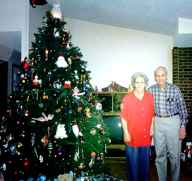
Art Morneweck and my wife, Charlotte (nick name Micky)
Click image for a larger view
|
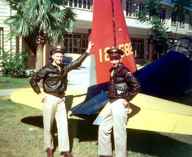
Art on right as cadet at Lakeland, Florida.
Click image for a larger
view
|
IN THE BEGINNING:
I received my civilian pilot's license in 1942. In 1943, I enlisted
in Army Air Forces. Basic training was in Miami Beach, Florida,
Then Gettysburg College for six months, then on to Maxwell Field
Pre-flight. Avon Park Florida and Lakeland Florida were next flying
the PT-17 Stearman Biplane. Finally, AT- 6 Texan training at Cockran
field, Georgia.
Sadly for me, in 1945 they had too many pilots.
I was sent to infantry, 40th division, 185th infantry, company
E, 1st squad, 1st platoon,
|
ARRIVAL: On
July 8,1945, I arrived at Leyte Island. On July 25,1945, I arrived
at Panay Island. Japan surrendered on August 14, 1945. On Sept.
8 or 15, 1945 we arrived at Inchon, Korea to accept the Japanese
surrender. We took a train to Taegu, Korea right away. Soon
we became an advance occupation party to Inchon, Korea and by
train to Taegu, Korea. We were the first American Soldiers in
Korea. The Japanese soldiers were still at their guard posts.
We relieved the Japanese and took over the occupation. I am
guessing that we were only about 20
men.
|
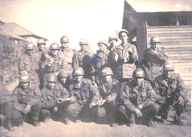 20
happy MP's
20
happy MP's
Click image for a larger view
|
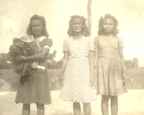 Three village girls on Panay Island of
Philippines
Three village girls on Panay Island of
Philippines
Click image for a larger view |
CHANGING THE GUARD:
We marched into the Japanese compound past the Japanese
guard and stopped in front of a two story building that we were
to use as our barracks. Before we could get settled, the C.O.
came into our squad room and told us to make full field pack
(with rations), get our rifles and ammunition. We were to march
to the city hall. When we arrived there, from three directions
came Japanese soldiers running toward us. We raised our rifles
getting ready for an attack but all they wanted to do was surrender
to us. They were afraid of the Korean Police.
|
|
Being the first squad there, we marched to each Japanese guard
post. The Japanese soldier on duty at each fell in on the rear
of our column as one of our men took over the guard post. It fell
to me to guard the ammo dump. It was raining very hard. The Japanese
soldiers were cordial and bowed to each of us as we replaced them.
When we got back from guard duty, the Japanese were gone.
|
GUARD DUTY: The
second day we were told the Japanese might try to break into
the city hall to destroy records. That night we were placed
around the building - nothing happened. One of our men lied
about his age and was only 17. Here comes the kicker! We were
the only regular army troops there so we were given MP Helmets,
MP Arm Bands, and 45 caliber revolvers and told to work with
the Korean Police. We set up our radios in police stations to
talk to our jeep.
|
 Four GI's and Taegu oxen .
Click image for a larger view
Four GI's and Taegu oxen .
Click image for a larger view |
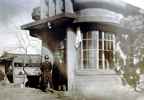
Taegu police station with
MP and Korean police, we kept our radio dispatcher up stairs.
Click image for a larger
view
|
THE RED LIGHT DISTRICT:
There was a city block of
houses built side by side facing the courtyard with no back
doors. There was only one way in or out. This was the whorehouse
district. We were there to keep GI's out. I don’t know
how they would get in but a Korea madam would often come running
out saying "American, American." We would have to
go in checking every room kicking them out.
OUR OUTPOST:
Four of us were put at a out-post many
|
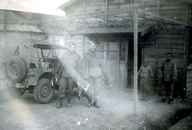
Art on right after duck hunt at the outpost.
Click image for a larger view
|
miles from town at
bottom of some mountains. Every morning a
jeep with a hot stove would come and make us hot breakfast, the
rest of day we had nothing but k-rations. One time two of us
took our rifles and got a few |
 Our MP Platoon.
Our MP Platoon.
Click image for a larger
view |

Outpost
near Taegu.
Click image for a larger
view
|
ducks instead of k-rations. We were
guarding a large barn. One day we looked in the barn and it was
full of rice bowls. Many miles away another 4-man post was guarding
parachutes
|
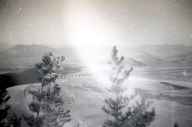 A long bridge from Taegu to our outpost.
Every morning we watched for the jeep that would bring us a hot
breakfast, the rest of day -k-rations.
A long bridge from Taegu to our outpost.
Every morning we watched for the jeep that would bring us a hot
breakfast, the rest of day -k-rations.
Click image for a larger view |
|
THE OUTHOUSE: The
Korean toilets were oblong holes in the floor. There were Korean
"honey dippers" who would take away the human waste
and spread it on their food gardens. Was this the reason every
thing grew twice as large as ours? We were not allowed to eat
any thing that came from the ground for obvious reasons.
Souvenirs:
We did not destroy any arms; I assumed the Japanese took them
home with them. There was a room that had a few things we could
have, I brought back a sword. We did turn in our rifles and they
were dunked in some preservative goop.
|
GOIN' HOME:
I left Korea on February 26, 1946 and discharged on March 20,
1946. When I was at Taegu we (GI's ) had no problems with the
Korean people and knew nothing about political problems, we
just wanted to go back to the states. I was in 40th division,
185th infantry, company E, 1st platoon, 1st squad.
HOME AT LAST: When
I was 20, I enlisted in the Army Air Forces Cadet Program. I
met my future wife on a double date. About 10 months later,
when I was on furlough, I married Charlotte (Micky) Matthews.
I was 22 and she was 21. I was gone for the next two years until
my 1946 discharge.
|

On way back home stopped at Shanghai, China
to pick up some Chinese civilians some officers lost their staterooms.
Click image for a larger view
|
HAPPILY
EVER AFTER: I got a job servicing
and programming office equipment. After 40 years I retired from
TRW. We have two daughters ,a son-in-law, and grandson. My wife,
Micky, after 57 good years of marriage, died in December 2001.
I have my children close to me. I am living with my youngest
daughter, Toni Morneweck. We live about five houses away from
my oldest daughter and sun-in-law, Terry & Jack Ellis and
my grand-son Tim.. We are very close knit family. I keep my
days occupied with my family, friends, church, and surfing the
web on things that interest me like WWII.
|
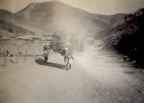 Taegu, Korea farmer with load of wood on
his back.
Taegu, Korea farmer with load of wood on
his back.
Click image for a larger view |
I took these pictures in the
Philippines and Taegu, Korea. My grandson, Tim Ellis, scanned
them for me.
Some names I recall from those days are:
Kaiser, Gregory, Calvert, Avery, Gansen, Averett, Graves, Combs,
Lewis, Fitzgerald, Fitzpatric, Edson, Morneweck.
|
 Taegu oxen.
Taegu oxen.
Click image for a larger view |
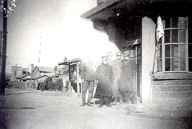 Two MP's at Taegu police station
Two MP's at Taegu police station.
Click image for a larger view |
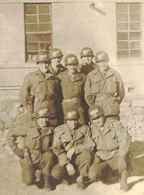
Eight MP's in
front of the barracks.
Click
image for a larger view
|
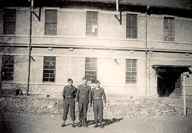
3 GI's (MP) in front of barracks.
Click image for a larger
view |

Send Corrections, additions,
and input to:
|